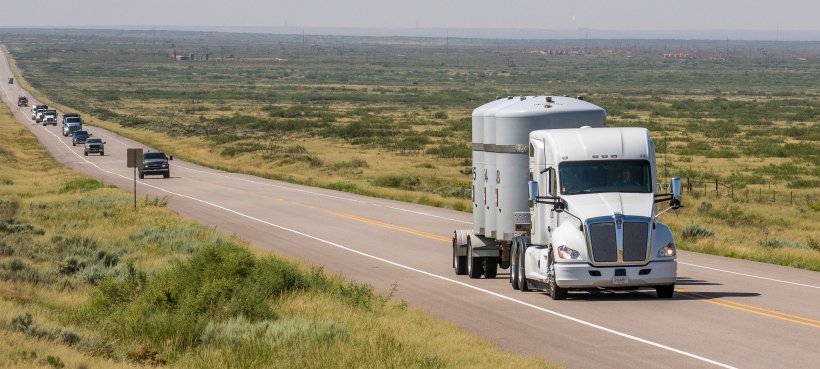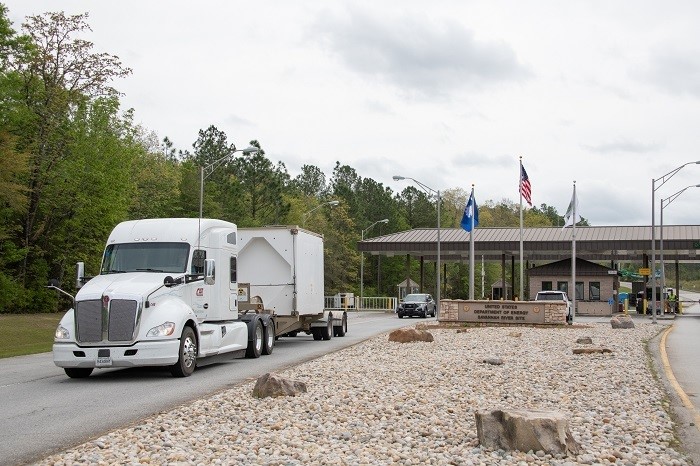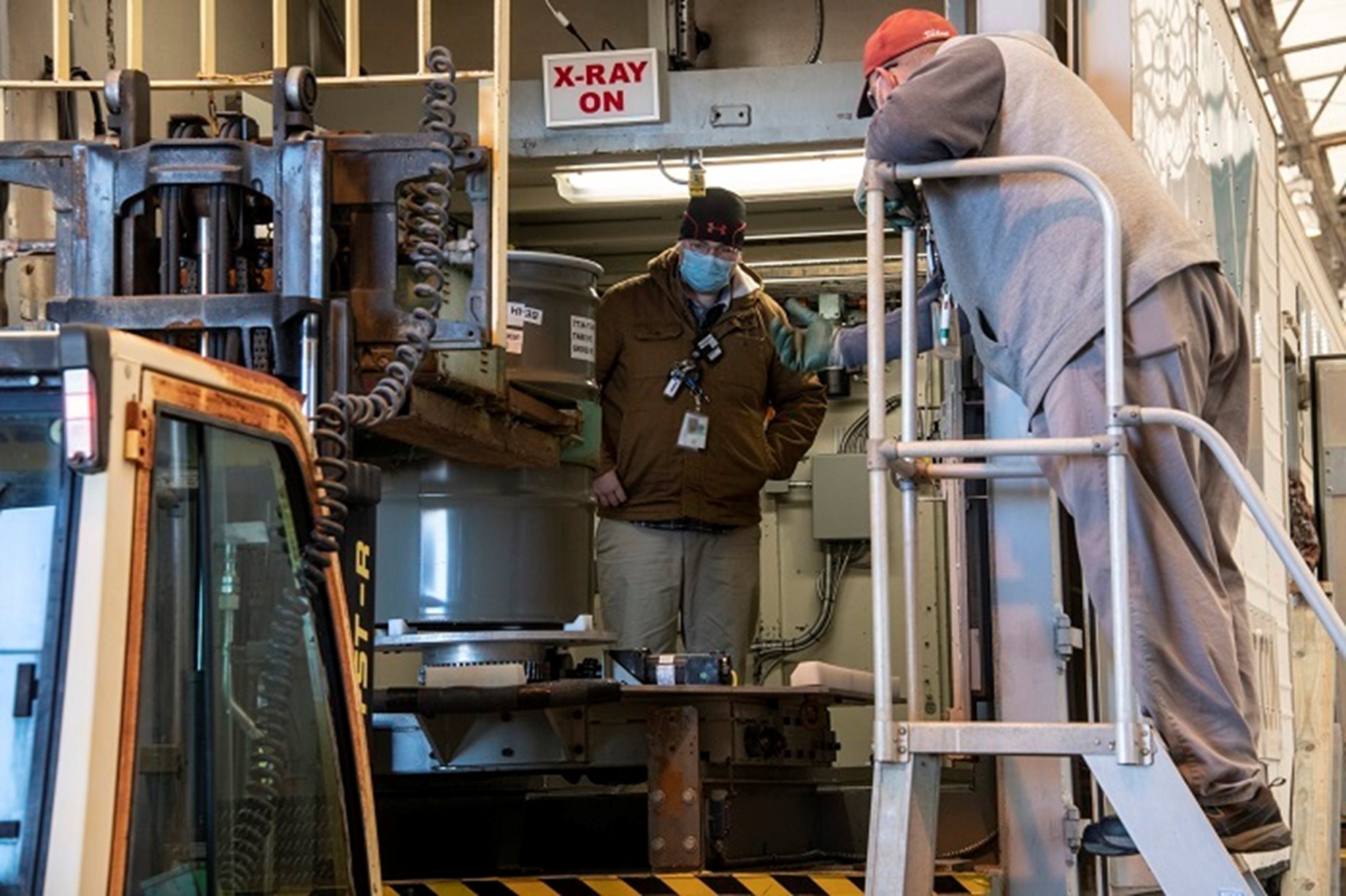TRU drum storage in the Solid Waste Management Facility in 1998 before WIPP opened (left) and in 2024 (right). (Photo: DOE)
The Solid Waste Management Facility (SWMF) at the Savannah River Site saw a large reduction of transuranic (TRU) waste in fiscal year 2024, achieving the highest volume of TRU waste shipped out of state by the facility in the past 10 years, according to the Department of Energy.
TRU waste typically consists of protective clothing, tools, rags, equipment, and miscellaneous items contaminated with small amounts of plutonium and other heavy elements.
A screen shot of a video marking the 25th anniversary of operations at the WIPP disposal facility. (Image: DOE)
The Department of Energy’s Office of Environmental Management celebrated a major milestone for the Waste Isolation Pilot Plant last week, marking the 25th anniversary of the receipt of the first waste shipment at the disposal facility in New Mexico’s Chihuahuan Desert.
A waste transport delivery truck heads for the WIPP site in New Mexico. In 2023, the repository saw its best shipment performance in 10 years. (Photo: DOE)
The Department of Energy’s Office of Environmental Management announced last week that, for calendar year 2023, the department’s Waste Isolation Pilot Plant (WIPP) had its best shipment performance in 10 years, having received 489 transuranic (TRU) waste shipments from generator sites throughout the country. For comparison, WIPP received only 272 shipments in 2022.
A continuous miner machine cuts into salt rock as mining begins on Panel 11, one of WIPP’s next waste disposal panels. (Photo: DOE)
For the first time in a decade, crews have started mining a new disposal panel at the Department of Energy’s Waste Isolation Pilot Plant (WIPP) in New Mexico, the nation’s deep geologic waste repository for defense-related transuranic waste.
Mining crews view progress in an ongoing mining tunnel, known as a drift, at the WIPP facility in New Mexico. (Photo: DOE)
The New Mexico Environment Department (NMED) signed a final order approving a 10-year permit renewal for the Waste Isolation Pilot Plant (WIPP), the nation’s deep geologic repository for defense-related transuranic (TRU) waste.
The Waste Isolation Pilot Plant, near Carlsbad, N.M. (Photo: DOE)
The Department of Energy’s Office of Environmental Management and the New Mexico Environment Department (NMED) have negotiated a settlement on terms to renew the 10-year operating permit for the Waste Isolation Pilot Plant near Carlsbad, N.M. The DOE, along with WIPP’s operating contractor, Salado Isolation Mining Contractors, and the NMED negotiated the settlement with New Mexico stakeholders.
A radiological control technician checks radiation readings on waste containers at WIPP. (Photo: WIPP)
The New Mexico Environment Department (NMED) is adding several conditions to the operating permit for the Department of Energy’s Waste Isolation Pilot Plant (WIPP) near Carlsbad, N.M. The permit changes, which would prioritize the disposal of transuranic (TRU) waste generated in the state and limit the repository’s capacity, are contained in a fact sheet the NMED.
Workers walk down a passageway in Panel 8 at the Waste Isolation Pilot Plant in November. (Photo: DOE)
Employees have begun emplacing defense-related transuranic (TRU) waste in Panel 8 of the Waste Isolation Pilot Plant (WIPP) in New Mexico, the Department of Energy’s Office of Environmental Management (EM) announced in November. TRU waste is permanently disposed of at WIPP in rooms mined in a Permian salt bed 2,150 feet below the surface.
The final legacy TRU waste shipment from Savannah River Site departs the site in mid-April, on its way to WIPP in southeastern New Mexico for permanent disposal. (Photo: DOE)
The Department of Energy reported this month that the final container of legacy transuranic waste from the Savannah River Site arrived at the Waste Isolation Pilot Plant for permanent disposal on the afternoon of April 14. The shipment capped the end of a journey for 239 shipments that began in 2011.
In all, trucks that carried the shipments weighed a combined 11,402,000 pounds and travelled more than 347,000 miles to the WIPP site.
Operators load a TRU waste drum into a real-time radiography unit for characterization at the Solid Waste Management Facility at the Savannah River Site. (Photos: DOE)
Operators at the Savannah River Site’s Solid Waste Management Facility can now characterize and certify newly generated TRU waste through the use of a real-time radiography unit that uses an X-ray system to examine the contents of waste containers. The equipment was recently installed to meet updated requirements set by the Department of Energy’s National TRU Program that involve evaluating the containers for chemical compatibility and oxidizing chemicals.
The shipments of TRU waste from SRS, in South Carolina, are sent to the Waste Isolation Pilot Plant (WIPP), in New Mexico, for disposal.
An electric continuous miner machine chews through the last wall of salt in Panel 8’s Room 7 of the Waste Isolation Pilot Plant to complete the rough cut of the panel. (Photo: DOE)
The Department of Energy’s Office of Environmental Management this week announced that after seven years, mining of the Waste Isolation Pilot Plant’s Panel 8 is finished. Created from an ancient salt formation 2,150 feet below the surface, Panel 8’s seven emplacement rooms are the next destination for transuranic waste brought to WIPP from DOE sites throughout the country.
A map of the Waste Isolation Pilot Plant underground, with a focus on Panels 7 and 8 at right. (Source: DOE EM)
The amount of salt mined so far from Panel 8 at the Department of Energy’s Waste Isolation Pilot Plant (WIPP) is a lot. The DOE’s Office of Environmental Management (EM) compared the amount to the weight of more than 46,000 Ford F-150s, about 16,000 African bush elephants, nearly 510 Boeing 747s, two Titanics, or enough to coat the rims of 3.6 million margarita glasses.
Miners working 2,150 feet underground extract the salt using grinders called continuous miner machines to create space to place defense-related transuranic (TRU) waste.
With WIPP’s Panel 8 scheduled for completion in a little more than half a year, crews recently crossed the 100,000-tons-mined threshold and, as of mid-June, are at 105,000 tons removed from the panel.

















